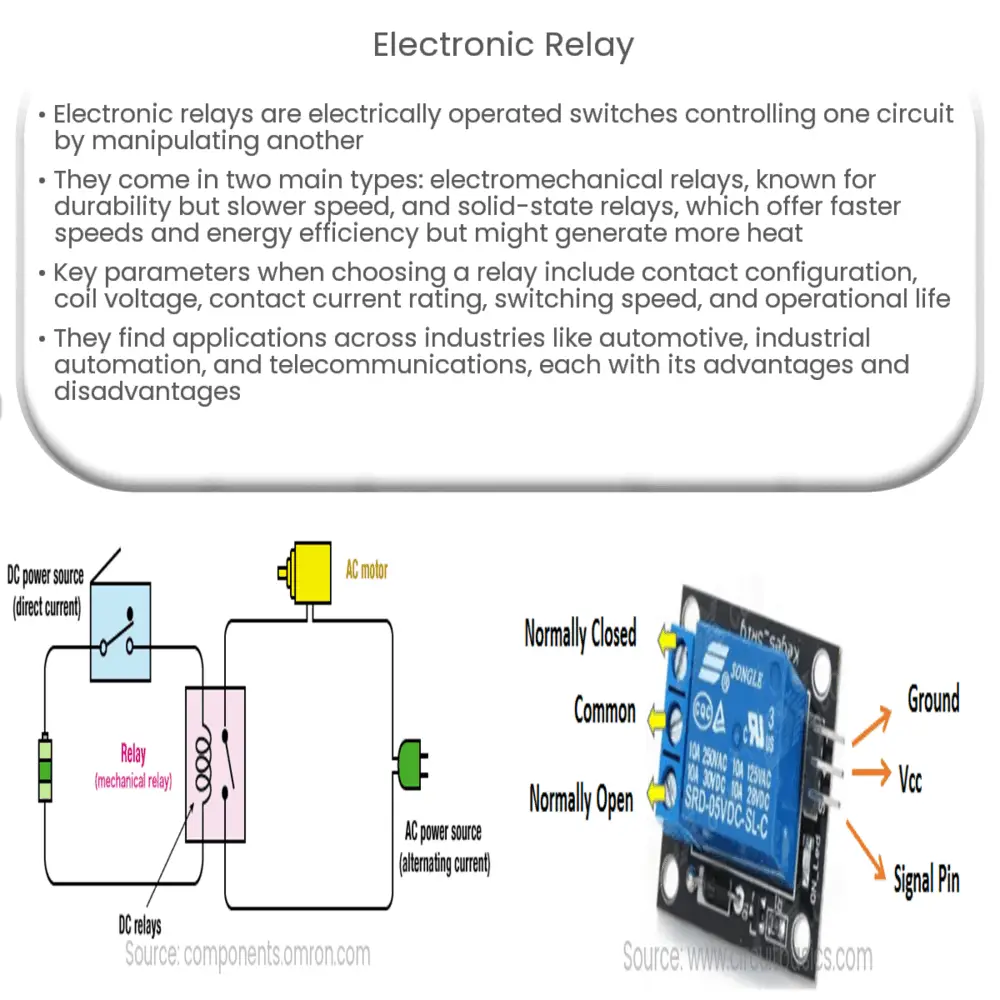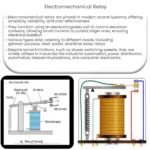An electronic relay is an electrically operated switch that controls one circuit by opening or closing contacts in another, providing isolation and protection.

Understanding Electronic Relays: An Introduction
What is an Electronic Relay?
An electronic relay is a type of electrically operated switch that allows for the control of one electrical circuit by opening or closing the contacts in another circuit. These devices are essential in many electrical systems, as they provide isolation between different voltage levels, protect circuits from overloads, and enable complex control logic.
Types of Electronic Relays
Electronic relays can be broadly classified into two categories based on their mechanism of operation: electromechanical relays and solid-state relays.
1. Electromechanical Relays
Electromechanical relays are the most common type of relay, and they operate using an electromagnet to mechanically open or close the contacts. These relays consist of a coil, an armature, and one or more sets of contacts. When a current flows through the coil, it creates a magnetic field that attracts the armature, causing it to move and either open or close the contacts. Electromechanical relays are known for their durability and reliability but can be slower in operation due to their moving parts.
2. Solid-State Relays
Solid-state relays (SSRs) have no moving parts and instead use semiconductor devices, such as transistors or thyristors, to switch the current on or off. These relays offer several advantages over electromechanical relays, including faster switching speeds, lower power consumption, and a longer operational life. However, they may be more susceptible to damage from voltage spikes and can generate more heat during operation.
Key Parameters to Consider When Selecting a Relay
When choosing an electronic relay for a specific application, it’s important to consider several key parameters:
- Contact Configuration: The arrangement of the relay’s contacts, such as single-pole single-throw (SPST), single-pole double-throw (SPDT), or other configurations, will determine the relay’s ability to switch between circuits or control multiple circuits simultaneously.
- Coil Voltage: The voltage required to activate the relay, which must be compatible with the control circuit’s voltage.
- Contact Current Rating: The maximum current the relay’s contacts can handle without damage. This value should be higher than the expected load current.
- Switching Speed: The time it takes for the relay to change states (open or close the contacts), which can be critical in some applications.
- Operational Life: The number of switching cycles the relay can perform before failure, which can vary greatly depending on the type of relay and the application’s requirements.
Common Applications of Electronic Relays
Electronic relays are widely used in various industries and applications, including:
- Automotive: Relays play a crucial role in controlling various systems in vehicles, such as headlights, turn signals, and fuel pumps.
- Industrial Automation: Relays are used to control motors, pumps, solenoids, and other equipment in automated systems.
- Power Distribution: Relays are essential in protecting electrical systems from overloads, short circuits, and other faults by isolating and disconnecting affected circuits.
- Telecommunications: Relays are used in telephone exchanges and other communication systems for signal routing and switching.
- Consumer Electronics: Relays can be found in home appliances, such as washing machines and air conditioners, where they control different functions and operating modes.
Advantages and Disadvantages of Electronic Relays
Electronic relays offer several advantages and disadvantages, which should be considered when selecting a relay for a specific application:
Advantages:
- Isolation: Relays provide electrical isolation between the control circuit and the load circuit, which can help prevent damage to sensitive components and improve safety.
- Versatility: Relays can be used to control a wide range of voltages and currents, making them suitable for various applications.
- Reliability: Electromechanical relays, in particular, are known for their durability and long operational life, making them suitable for heavy-duty applications.
- Low Power Consumption: Solid-state relays consume very little power during operation, which can be beneficial in energy-efficient systems.
Disadvantages:
- Switching Speed: Electromechanical relays can be slower than solid-state relays due to their moving parts, which may not be suitable for high-speed applications.
- Size and Weight: Some electromechanical relays can be bulky and heavy, which may not be ideal for compact or portable systems.
- Heat Generation: Solid-state relays can generate more heat during operation, requiring additional cooling or heat management measures.
- Cost: Solid-state relays can be more expensive than electromechanical relays, particularly for high-current applications.
Conclusion
Electronic relays are essential components in many electrical systems, providing reliable and versatile switching capabilities. Understanding the differences between electromechanical and solid-state relays, as well as their key parameters and applications, can help engineers and designers select the most suitable relay for their specific needs. By considering the advantages and disadvantages of each type of relay, an informed decision can be made to optimize system performance, reliability, and cost-effectiveness.




